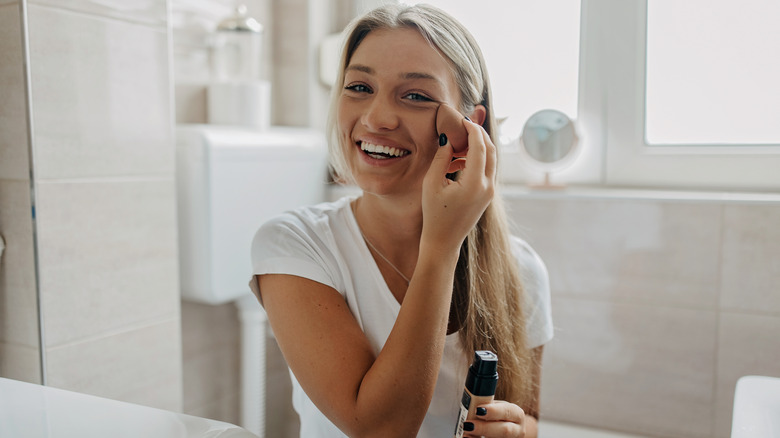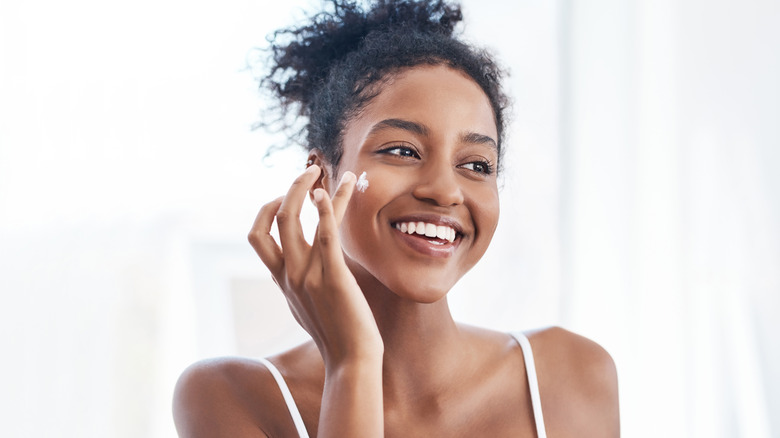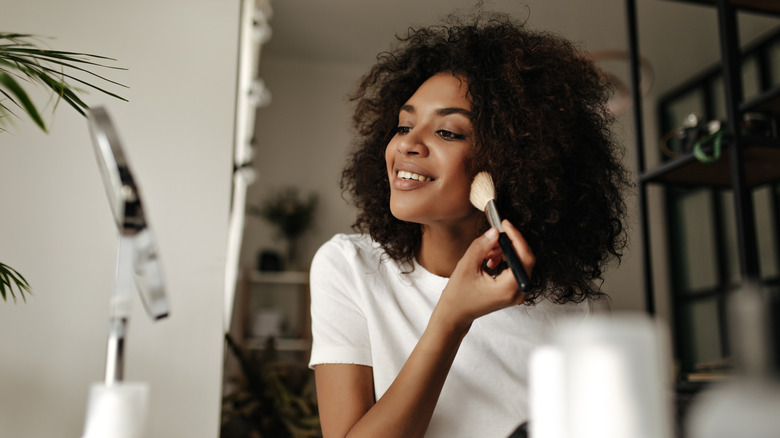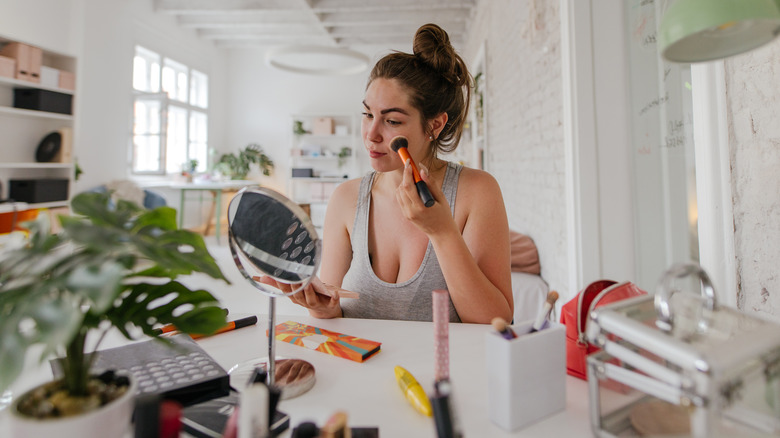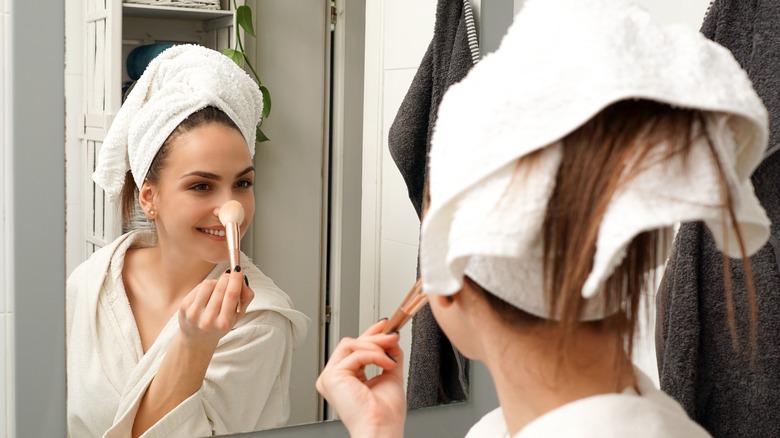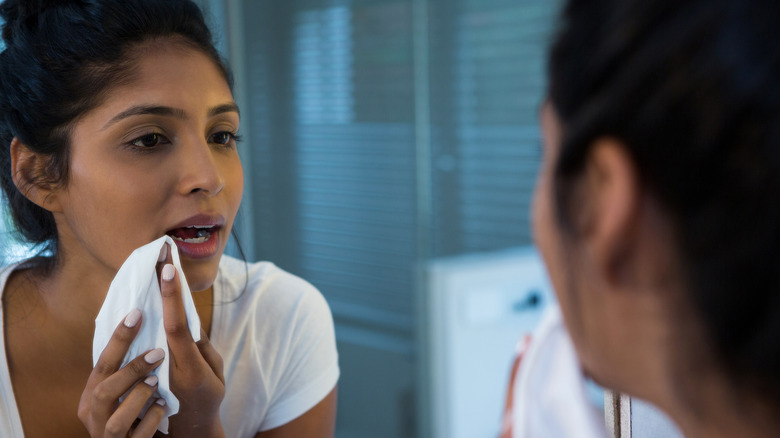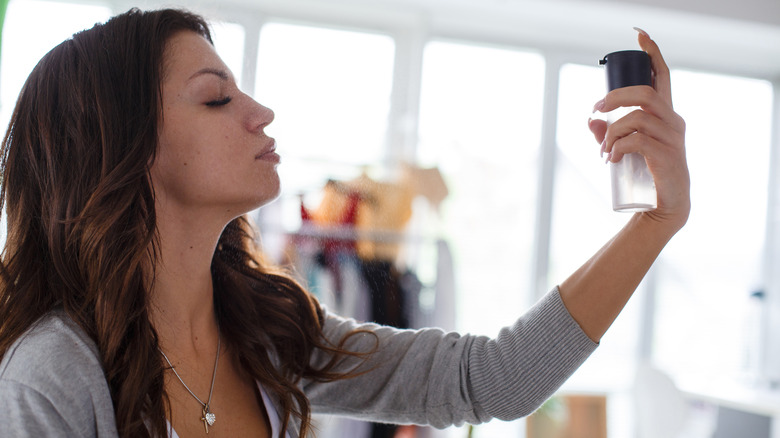Easy Application Tips For Flawless Foundation (Yes, Smooth & Silky Makeup Is Within Reach)
Foundation is a lifesaver when it comes to evening skin tone and creating that airbrushed-skin finish. You'll find it in pretty much every makeup bag and professional MUA's kit and on the faces of women (and some men, of course) everywhere.
But here's the catch: Even if foundation is most people's go-to secret weapon for a flawless-looking complexion, it's not foolproof. And badly applied foundation can actually make you look less polished. You might struggle with streakiness, separating patches of pigment, the cakey makeup look, a color that doesn't match your neck, product that disappears after just a few hours... You get the idea.
If you've been swiping on foundation since you were a teenager, chances are you picked up some bad habits that have stuck around years later, especially if no one taught you the right way to apply it. Thankfully, it's never too late to learn. Follow these super simple foundation application tips for a smooth finish every time.
Prime your skin
The first step of proper foundation application doesn't actually involve foundation at all — it's all about getting your skin prepped and primed. Friendly reminder: Foundation will never replace good skin care habits, so make sure your face is clean and hydrated before your makeup goes anywhere near it. Exfoliating a couple of times per week can also buff away unwanted texture so your foundation glides on like silk.
You should also apply a makeup primer before going in with foundation. "Primer is essential as it locks moisture into your skin to help prevent makeup disappearing when your pores start to perspire," Lan Nguyen-Grealis, an award-winning makeup artist, explained to Stylist. A good primer can, in some cases, even take the place of your morning moisturizer — at least according to Beyoncé's makeup artist. Sir John, the man responsible for Bey's beauty looks, told Allure that your primer can do the work of both products if you're in a situation where your foundation may easily slide off, like during a tropical beach vacation or, say, if you'll be headlining Coachella (never rule it out). This trick might also come in handy if your skin is naturally oily. However, if you have dry or mature skin, it's best to keep the moisturizer in your routine and follow up with a primer that'll seal it all in.
Choose your tools and foundation carefully
If you've struggled to make your foundation work for your skin, you might be using a product that doesn't suit your complexion. First things first: Get your shade right. "Test out the color on your jawline and make sure you're looking at it in natural light to see all the nuances of the shade and how it'll look in person," celebrity makeup artist Mai Quynh shared with Oprah Daily. Generally, people tend to go too dark rather than too light, so if you're stuck choosing between two shades, opt for the lighter one.
When deciding between liquid or powder, it all comes down to skin type. Powder foundation is best for you if you have oily skin, while dry complexions can benefit from the moisture found in liquid formulations.
The applicator that comes with your foundation (if there is one) may not offer the smoothest finish, so consider stocking up on other tools to get the job done. "I find brushes give you the best application; they don't soak up product like sponges tend to do, which also makes them the most hygienic," Amy Conway, BB Pro Artist at Bobbi Brown, explained to Good Housekeeping. "I turn to sponges when I want a more matte finish, and use them to press off any excess foundation," she added.
Dab on foundation for smooth coverage
Among the many things we wish we'd been taught in school but weren't, foundation isn't meant to be rubbed on the skin. Instead, many experts recommend dabbing or patting it on. "I like to use a foundation brush to pat on the foundation. I never swipe it on because I feel like that results in a streaky foundation," celebrity makeup artist Renée Loiz revealed to Who What Wear. Cover your brush with just a little pigment — it's always safer to add foundation gradually than to apply too much at once and end up with cakiness. For liquid foundation, pump a small amount onto the back of your hand, then dip the brush in the foundation to apply to your face.
When patting the product onto the skin, focus on one area (such as your forehead) at a time, until the foundation is evenly distributed. You can spend extra time buffing it into areas that require more coverage, such as blemished or discolored patches.
And as an extra tip, if you do find yourself rubbing or brushing on foundation in longer strokes when blending, be sure to at least go in the right direction. Swiping up will brush any facial fuzz up, causing the product to cling to your hairs rather than your skin. Brushing down will create a smoother look and conceal those baby hairs on your cheeks.
Start from the center of the face
If your goal is to nail the no-makeup makeup look, you'll want to avoid doing anything that leaves your foundation looking blotchy and uneven. One way to ensure you're building coverage in all the right places is to apply foundation in the center of your face first. "Start in the center of the face, on the apples of the cheeks, and slowly blend out," Violette, a makeup artist and CEO of beauty brand VIOLETTE_FR, told Vogue. Besides making it easier to blend, the center of the face also tends to have the most shadowing and discoloration. And, as long as your foundation shade matches your natural skin tone, it'll look the most natural when gradually faded toward the hairline (meaning there's no need to be heavy-handed near the perimeter of your face).
You may have heard at one point or another that foundation should extend to your neck, but applying makeup below the face just wastes precious product and puts your clothes at risk of getting stained. Troy Surratt, a makeup artist, revealed to Insider that while he does apply foundation to models' necks for photo shoots, it's not a necessary step for everyday makeup. Blend a little foundation below the jawline, just to avoid any harsh lines, and leave the rest bare (besides sunblock, of course).
Correct overzealous application
If you went a little crazy with the foundation — especially if you're struggling with more acne spots or trouble areas than usual — you'll likely be left with a cakey, unnatural coating. "Applying too much product can lead to an uneven application—especially if you are using a powder-finish product," makeup artist Nick Lujan explained to Byrdie. "Too many layers of powder finish tend to make the skin look textured/dry. Also, the layers tend to repel each other, creating a blotchy appearance and camera flashback." Yikes!
Thankfully, there's a fix for heavy foundation. Start by gently wiping off excess makeup with a clean towel or tissue in the areas where it's most caked on. Then, blend again with your brush. You can also use a makeup sponge to soak up some of the residue.
Finally, grab a light face moisturizer, which basically acts as an eraser in a bottle. As makeup artist Elisa Flowers shared with Teen Vogue, "If you feel like your foundation is looking too heavy, add a dab of moisturizer and rub it onto skin in small circles with fingertips or a kabuki brush. Then use a damp sponge to blot any excess product off."
Complete the look with concealer and setting spray
Once you've dabbed and blended your foundation to perfection, check for any spots that need a little extra coverage. You should always layer concealer over foundation rather than dotting concealer on first, so now's the time to touch up any blemishes or under-eye circles.
Next, mist on a setting spray for a dewy, glazed donut finish. These sprays lock your foundation and other makeup in place so it doesn't slide around or crease throughout the day. Along with primer, setting spray is an extra step that gives your foundation a boost and might eliminate all those trips to the restroom to touch up.
With that said, you don't need to rely on a setting spray every day, and doing so could even mess with your complexion. These mists often contain alcohol, which might irritate and dry out some skin types (via Everyday Health). Makeup artist Mia Yang summed it up to Byrdie: "Please keep in mind that setting spray is not for everyday use and a little goes a long way. A light mist is more than enough."
